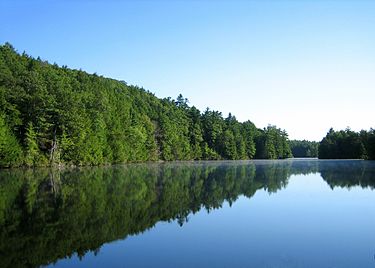The Connecticut Portal

Connecticut (/kəˈnɛtɪkət/ kə-NET-ik-ət) is the southernmost state in the New England region of the Northeastern United States. It borders Rhode Island to the east, Massachusetts to the north, New York to the west, and Long Island Sound to the south. Its capital is Hartford, and its most populous city is Bridgeport. Connecticut lies between the major hubs of New York City and Boston along the Northeast Corridor, where the New York metropolitan area, which includes six of Connecticut's seven largest cities, extends well into the southwestern part of the state. Connecticut is the third-smallest state by area after Rhode Island and Delaware, and the 29th most populous with slightly more than 3.6 million residents as of 2020, ranking it fourth among the most densely populated U.S. states.
The state is named after the Connecticut River, the longest in New England which roughly bisects the state and drains into the Long Island Sound between the towns of Old Saybrook and Old Lyme. The name of the river is in turn derived from anglicized spellings of Quinnetuket, a Mohegan-Pequot word for "long tidal river". Before the arrival of the first European settlers, the region was inhabited by various Algonquian tribes. In 1633, the Dutch West India Company established a small, short-lived settlement called House of Hope in Hartford. Half of Connecticut was initially claimed by the Dutch colony New Netherland, which included much of the land between the Connecticut and Delaware Rivers, although the first major settlements were established by the English around the same time. Thomas Hooker led a band of followers from the Massachusetts Bay Colony to form the Connecticut Colony, while other settlers from Massachusetts founded the Saybrook Colony and the New Haven Colony; both merged into the former by 1664.
Connecticut's official nickname, the "Constitution State", refers to the Fundamental Orders adopted by the Connecticut Colony in 1639, which is considered by some to be the first written constitution in Western history. As one of the Thirteen Colonies that rejected British rule during the American Revolution, Connecticut was influential in the development of the federal government of the United States. In 1787, Roger Sherman and Oliver Ellsworth, state delegates to the Constitutional Convention, proposed a compromise between the Virginia and New Jersey Plans; its bicameral structure for Congress, with a respectively proportional and equal representation of the states in the House of Representatives and Senate, was adopted and remains to this day. In January 1788, Connecticut became the fifth state to ratify the Constitution. (Full article...)

The American Thermos Bottle Company Laurel Hill Plant, located in the Laurel Hill section of Norwich, Connecticut, in the United States, includes 11 contributing buildings and two other contributing structures. The original plant was built during 1912–13 and used a historic Italianate house as a company office building. The plant was the primary factory where Thermos brand vacuum flask bottles were manufactured from 1913 to 1984. The plant is historically significant to its connection to the Thermos Company and the history of Norwich. The complex is architecturally significant because it displays the adaptive use of industrial mill design to new industry. It was added to the National Register of Historic Places in 1989.
Since its nomination, numerous changes and renovations have occurred. The surrounding area has seen the construction of condominiums and the large manufacturing building being renovated and re-purposed for loft-style apartments. Renovations on the northern end of the property would require the demolition of two buildings to construct the Integrated Day Charter School. Completed in 2008, a new two-story addition created an indoor gymnasium, kitchen, offices and a new lobby for the school. (Full article...)General images -
Selected picture -

State facts
- Nicknames: The Provisions State, The Land of Steady Habits, The Constitution State, The Nutmeg State
- Capital: Hartford
- Governor: Ned Lamont (D)
- Lieutenant Governor: Susan Bysiewicz (D)
- Secretary of State: Stephanie Thomas (D)
- Attorney General: William Tong (D)
- Senators: Chris Murphy (D), Richard Blumenthal (D)
- Representatives: Jahana Hayes (D), Jim Himes (D), Joe Courtney (D), John B. Larson (D), Rosa DeLauro (D)
- Total area: 5,543 mi2
- Land: 4,845 mi2
- Water: 698 mi2
- Highest elevation: 2,379 ft (Mount Frissell)
- Population 3,576,452 (2015 est)
- Admission to the Union: January 9, 1788 (5th)
State symbols:
- Animal: Sperm whale
- Bird: American Robin
- Fish: American Shad
- Flower: Mountain Laurel
- Fossil: Dinosaur Track
- Insect: European Praying Mantis
- Ship: USS Nautilus (SSN-571)
- Songs: Yankee Doodle
- Tree: Charter Oak
- Mineral: Almandine
Selected article -

The Connecticut Colony or Colony of Connecticut, originally known as the Connecticut River Colony or simply the River Colony, was an English colony in New England which later became Connecticut. It was organized on March 3, 1636 as a settlement for a Puritan congregation, and the English permanently gained control of the region in 1637 after struggles with the Dutch. The colony was later the scene of a bloody war between the colonists and Pequots known as the Pequot War. Connecticut Colony played a significant role in the establishment of self-government in the New World with its refusal to surrender local authority to the Dominion of New England, an event known as the Charter Oak incident which occurred at Jeremy Adams' inn and tavern.
Two other English settlements in Connecticut were merged into the Colony of Connecticut: Saybrook Colony in 1644 and New Haven Colony in 1662. (Full article...)Did you know? -
- ... that Nathan Agostinelli stomped on a Viet Cong flag during his campaign for Connecticut State Comptroller?
- ... that a variety of the Connecticut field pumpkin is known as "the original commercial jack-o'-lantern pumpkin"?
- ... that Darien, Connecticut, was once home to a train station built inside a cemetery?
- ... that Cora Slocomb di Brazza designed the peace flag adopted by the International Council of Women, and her mother Abby Day Slocomb designed the Connecticut state flag?
- ... that New Haven, Connecticut, was home to the world's first commercial telephone exchange?
- ... that a Connecticut radio station was "the loser in a survival-of-the-fittest battle"?
In the news

- February 10: Disney to shut down Blue Sky Studios, animation studio behind 'Ice Age'
- October 17: Hundreds arrested for 'dark web' child porn by international task force
- October 3: World War II era plane crashes in Connecticut, US, killing at least seven
- February 21: Sixteen states sue U.S. President Trump to stop declaration of emergency for border wall
Categories
Related WikiProjects

WikiProject Connecticut • WikiProject Connecticut routes • WikiProject UCONN
Selected panorama
Topics
Related portals
Associated Wikimedia
The following Wikimedia Foundation sister projects provide more on this subject:
-
Commons
Free media repository -
Wikibooks
Free textbooks and manuals -
Wikidata
Free knowledge base -
Wikinews
Free-content news -
Wikiquote
Collection of quotations -
Wikisource
Free-content library -
Wikiversity
Free learning tools -
Wikivoyage
Free travel guide -
Wiktionary
Dictionary and thesaurus























































